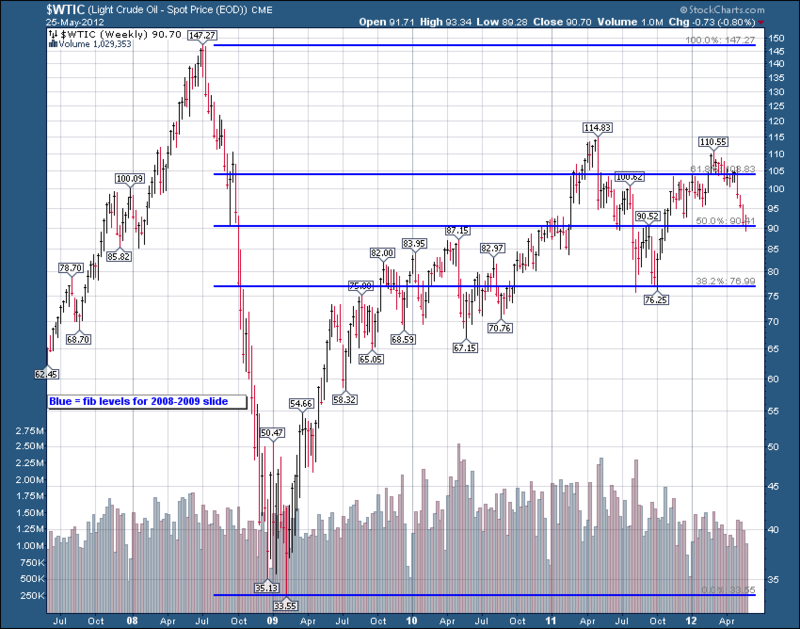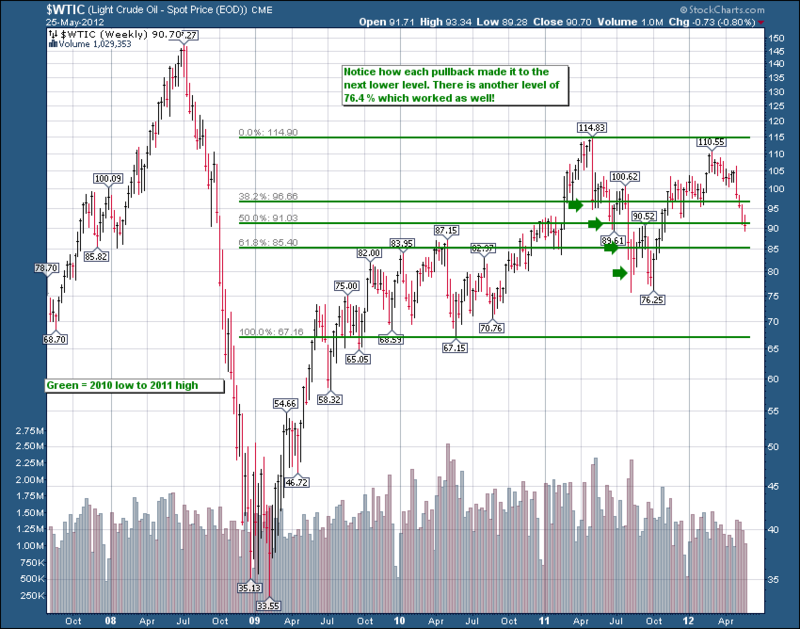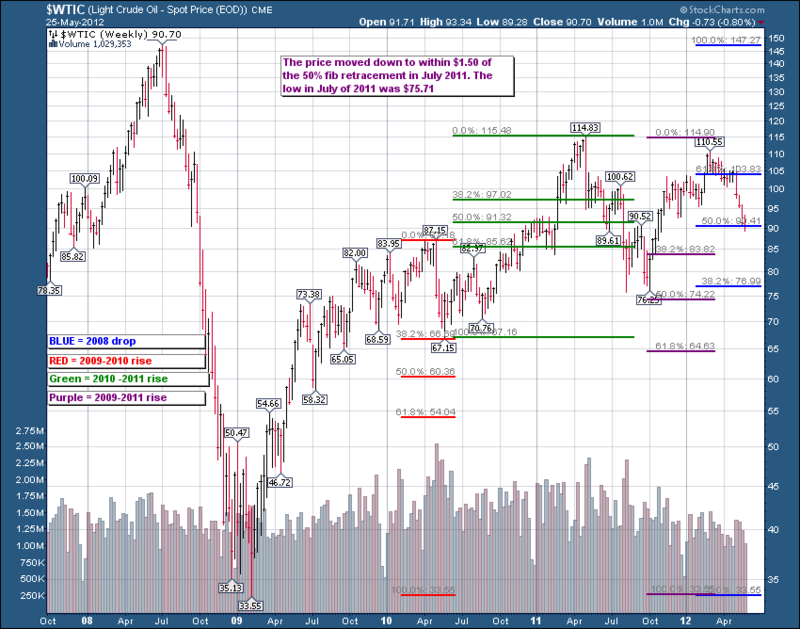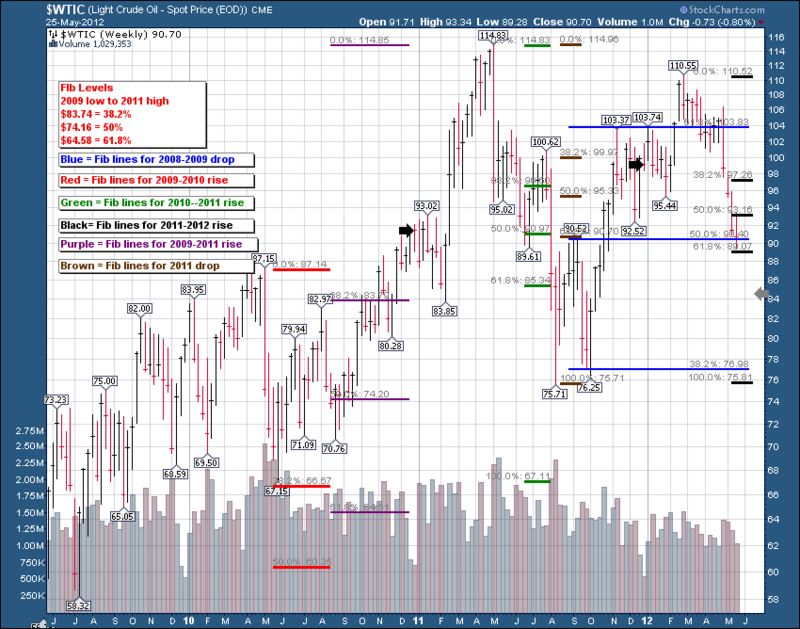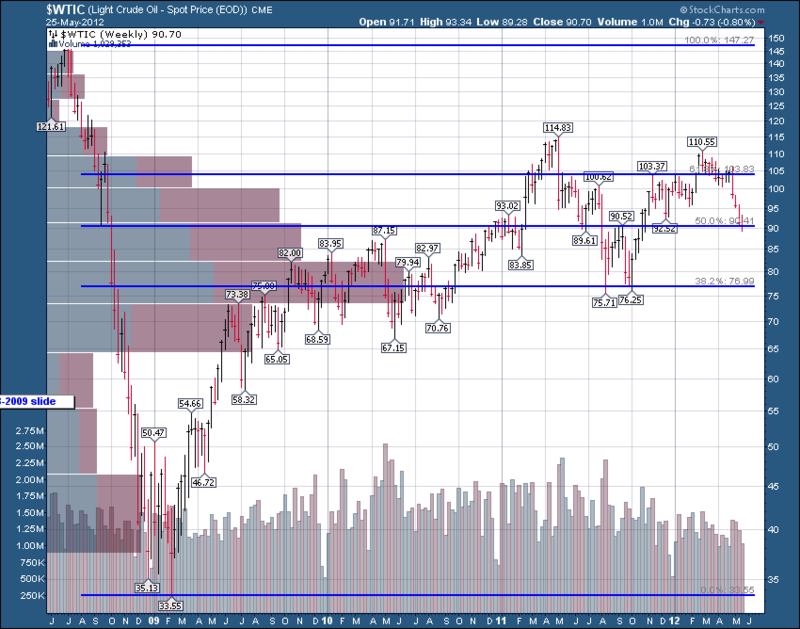Crude is what makes the world go around!
Living in the heart of oilville (thats not olive oil!) we pay particular attention to crude. Currently crude trades below Alberta government budget forecasts as well as industry budget numbers. I believe Cenovus used $104.
Crude spiked into the high $80's last week and sent the planners back to the budget drawing board. Oil budgeting is never easy.
Today I want to walk through a series of charts that lay out $WTIC price movements since we hit our highs in 2008. Its a fascinating walk through fibonacci levels. I have previously discussed how crude trades off fib levels but this current discussion is a great overview for ensuring you are trading with the trend.
Currently, the bears are in full control...or was that soooo last week?
Fibonacci levels are so interesting. I can't help but be amazed how often they are meaningful. Look how the price action following the big decline set up within the 38.2% and 61.8% levels. Almost 3 years later, the vast majority of price action is contained between those two levels. Looking farther to the left, you can see the market had to work hard to get through those same price levels. What was resistance becomes support and on the way down what was support becomes resistance. So on most of the charts to follow, I have placed these MAJOR fib levels on the right hand side of the chart in blue. Who knows how long it will take before we move outside the ranges?
Ok, so the slide was big. Next we had the rebound.
Wow, quite a bounce back!
We can see the 38.2% retracement was at $76.99 on the right hand side of the chart. The market stall between $74 and $75 (June through August 2010) was just shy of the retracement. The 50% retracement was at $90.41. When the market got to $87 it finally made a lower low. The pullback was (in Red) 38.2% retracement. Some would say it never reached the fib level. Lets split hairs but being within 3% of the target is pretty good. Notice how the trading range capped oil for a year. When it broke out, it more than doubled the channel width. The channel width was $20 and the breakout yielded $26. You don't need Fibonacci to double the channel width, as that is a common technical measurement. But moving a copy of the fib sequence up makes it easy (shown in Teal Blue). On a log chart this will not be double actual price.
Lets study the move of 2010 - 2011 and then we'll look at 2009-2011. Shorter time frame, then longer time frame. Analyzing a shorter time frame being the 2010 low to the 2011 high. These lines are drawn in Green. If you look closely, you will see that the price dropped just below each fib level before rebounding. For all the people who want exact levels, the price made it to the target each time. On the next thrust down it went through the next fib level. On the last thrust it really went down. There is a 76.4% retracement that is less common. It pushed through that. maybe the move will be to 100%. We might need more data that what is on this chart.
Well, the problem is, the price broke all three fib levels and even a fourth. What to do next? Lets study the move of 2009 to 2011. This is a longer period but might have valuable fib levels. The 2009-2011 is in purple as identified in the legend.
The purple set of lines goes from the 2009 lows to the 2011 top. Look how the retracement off the peak stopped at 50%. Once again a valuable clue of a place to look for support. It pulled back to within $1.50 of the fib level. Interestingly, it was also the 38.2% level from the 2008-2009 drop! Reversing the role of a support and resistance level, it became support.
So we have covered the blue, red, green and purple lines. I want to add two more on here. Normally I would put them on a separate chart, but the value comes from a confluence of fib levels showing up. So I don't apologize for the messiness of the chart. It really is messy !
So in Brown below, the levels of the bounce back up are important. The first bounce stopped at exactly 38.2%. Well, after pulling back, it took off and each week it was hitting and pulling back from each fib level. All the fib levels were important, but the price action pushed higher and went through each of them. Where did the push up end? At the fib levels of the 2008-2009 decline! Then, in an outstanding final thrust the price would push up $15 in 3 weeks.
Ok, so the recent highs are in, what happens now? Let's look at the black fib levels on the right hand side. We have just pulled back to 61.8% of the 2011-2012 move up. Will this be support? Well it has lots going for it, so I would expect a bounce at least. $90 is also the 50% of the 2008-2009 decline (blue). It is also just above the red level of the 2010 high. It is the 50% retracement of the 2010-2011 move up (green). It is the first retracement level of the 2011 move down(brown). That is a lot of confluence. As well, crude has moved about $20 which is meaningful. Lastly, the opening crude price of 2011 of $90 generates a level marked by the black arrow. You can see the market turned three times at that level after the calendar changed to 2011. You know the discussion, crude is up on the year or down on the year etc. etc.
OK, so what if crude does not find support here? Where would we look next? Well, at $84 to $86 dollars there are a confluence of levels again. Red, purple and green all have important levels near there. I have put a grey arrow there. Lastly, if that does not hold, I would expect a signifcant bottom at $74-$77. Again, the vast majority of price action has held between the 38.2% and 61.8% levels since 2008. A break through that would indicate huge trouble! Below is the original chart with volume by price selected on it.
So, the oil market is wild, woolly and moody. But these fib levels can help us find support and resistance.
Good Trading,
Greg Schnell, CMT

